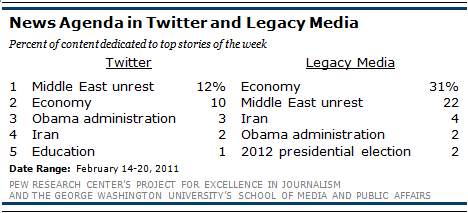The news agendas of the mainstream media and that of their analog presence on Twitter were strikingly similar during the week in which both were studied.
In all, during the week of February 14-20, 2011, four of the top five stories covered by traditional media were also the stories these outlets tweeted about most.
In the legacy platforms, the troubled U.S. economy and unrest in the Middle East filled most of the newshole-the time on television and radio and the space in print and online-studied by PEJ in its weekly News Coverage Index.[1] The economy filled 31% of the newshole PEJ studied, the Middle East 22% of the coverage. Attention to Iran came in at No. 3 (4%), and news about the Obama administration was No. 4 that week at 2%.

Those same stories also received the most attention on these outlets’ Twitter platforms, though the order varied. The Mid-East situation accounted for 12% of the tweets studied. The economy made up another 10%. Those were followed by relatively heavy interest in stories about the Obama administration (3% of tweets) and stories about the U.S.’s strained relationship with Iran (2%).[2]
Even with a similar emphasis on top stories, one difference in the way news functions in the legacy platforms versus on Twitter is priority. While the total number of posts on Twitter may be more about one subject than another, there is no structural hierarchy to posts. No one post is given higher priority, or "front-page status," other than in how much they are shared. In 140 characters, everything is fairly equal.
FOOTNOTES
[1] The legacy media sample is based on the front pages of newspapers, the home pages of websites, and the first 30 minutes of broadcast television, radio and cable programs.
[2] The two samples of outlets, both mainstream original platforms and Twitter accounts, were altered and made equivalent for the sake of comparison by removing The Daily Caller and Saturday content.


